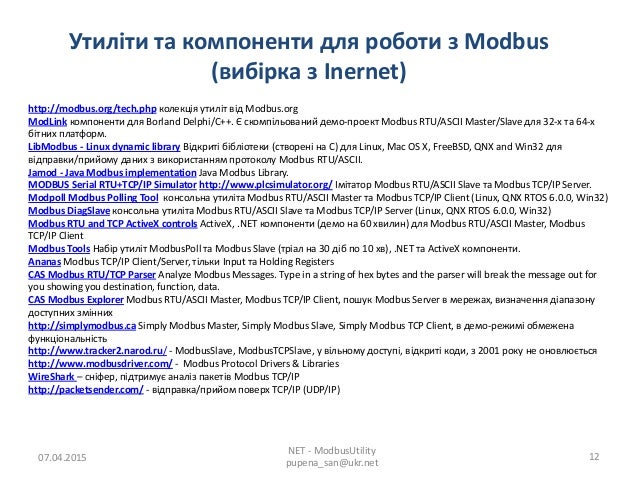
Modbus Serial Master Jamod 115th
Jamod - Java Modbus implementation. Example C, VB and Visual C++ code for Linux Modbus RTU communication. The FieldTalk(tm) utility modpoll is a command line based Modbus master simulator and test utility. Modpoll runs on Linux.
MODBUS TCP/IP Modbus TCP/IP Unplugged – An introduction to Modbus TCP/IP Addressing, Function Codes and Modbus TCP/IP Networking 1. OVERVIEW MODBUS TCP/IP is a variant of the MODBUS family of simple, vendor-neutral communication protocols intended for supervision and control of automation equipment. Specifically, it covers the use of MODBUS messaging in an ‘Intranet’ or ‘Internet’ environment using the TCP/IP protocols. The most common use of the protocols at this time are for Ethernet attachment of PLC’s, I/O modules, and ‘gateways’ to other simple field buses or I/O networks. The MODBUS TCP/IP protocol is being published as a (‘de-facto’) automation standard. Since MODBUS is already widely known, there should be little information in this document which could not be obtained elsewhere.
However, an attempt has been made to clarify which functions within MODBUS have value for interoperability of general automation equipment, and which parts are ‘baggage’ from the alternate use of MODBUS as a programming protocol for PLC’s. This is done below by grouping supported message types into ‘conformance classes’ which differentiate between those messages which are universally implemented and those which are optional, particularly those specific to devices such as PLC’s. Learn how the BFR3000-NNA1 Modbus Router can enable remote monitoring – 1.1 CONNECTION-ORIENTED In MODBUS, data transactions are traditionally stateless, making them highly resistant to disruption from noise and yet requiring minimal recovery information to be maintained at either end. Programming operations, on the other hand, expect a connection-oriented approach. This was achieved on the simpler variants by an exclusive ‘login’ token, and on the MODBUS Plus variant by explicit ‘Program Path’ capabilities which maintained a duplex association until explicitly broken down. MODBUS/TCP/IP handles both situations.
A connection is easily recognized at the protocol level, and a single connection may carry multiple independent transactions. In addition, TCP/IP allows a very large number of concurrent connections, so in most cases it is the choice of the initiator whether to reconnect as required or re-use a long-lived connection. Developers familiar with MODBUS may wonder why the connection-oriented TCP/IP protocol is used rather than the datagram-oriented UDP.
The main reason is to keep control of an individual ‘transaction’ by enclosing it in a connection which can be identified, supervised, and canceled without requiring specific action on the part of the client and server applications. This gives the mechanism a wide tolerance to network performance changes, and allows security features such as firewalls and proxies to be easily added. Similar reasoning was used by the original developers of the World Wide Web when they chose to implement a minimal Web query as a single transaction using TCP/IP on well-known port 80.
Ploytec Usb Audio Asio Driver Serial Numbers. Convert Ploytec Usb Audio Asio Driver trail version to full software. Asio sound driver download.
1.2 Data encoding MODBUS uses a ‘big-endian’ representation for addresses and data items. This means that when a numerical quantity larger than a single byte is transmitted, the MOST significant byte is sent first. So for example: 16 – bits 0x1234 would be 0x12 0x34 32 – bits 0x12345678L would be 0x12 0x34 0x56 0x78 1.3 Interpretation of reference numbers MODBUS bases its data model on a series of tables which have distinguishing characteristics. The four primary tables are input discretes single bit, provided by an I/O system, read-only output discretes single bit, alterable by an application program, read-write input registers 16-bit quantity, provided by an I/O system, read-only output registers 16-bit quantity, alterable by an application program, read-write The distinction between inputs and outputs, and between bit-addressable and word-addressable data items, do not imply any application behavior. It is perfectly acceptable, and very common, to regard all four tables as overlaying one another, if this is the most natural interpretation on the target machine in question. For each of the primary tables, the protocol allows individual selection of 65536 data items, and the operations of read or write of those items are designed to span multiple consecutive data items up to a data size limit which is dependent on the transaction function code. There is no assumption that the data items represent a true contiguous array of data, although that is the interpretation used by most simple PLC’s The ‘read and write general reference’ function codes are defined to carry a 32 bit reference number, and could be used to allow direct access to data items within a VERY large space.
Today there are no PLC devices which take advantage of that. One potential source of confusion is the relationship between the reference numbers used in MODBUS functions, and the ‘register numbers’ used in Modicon PLC’s.